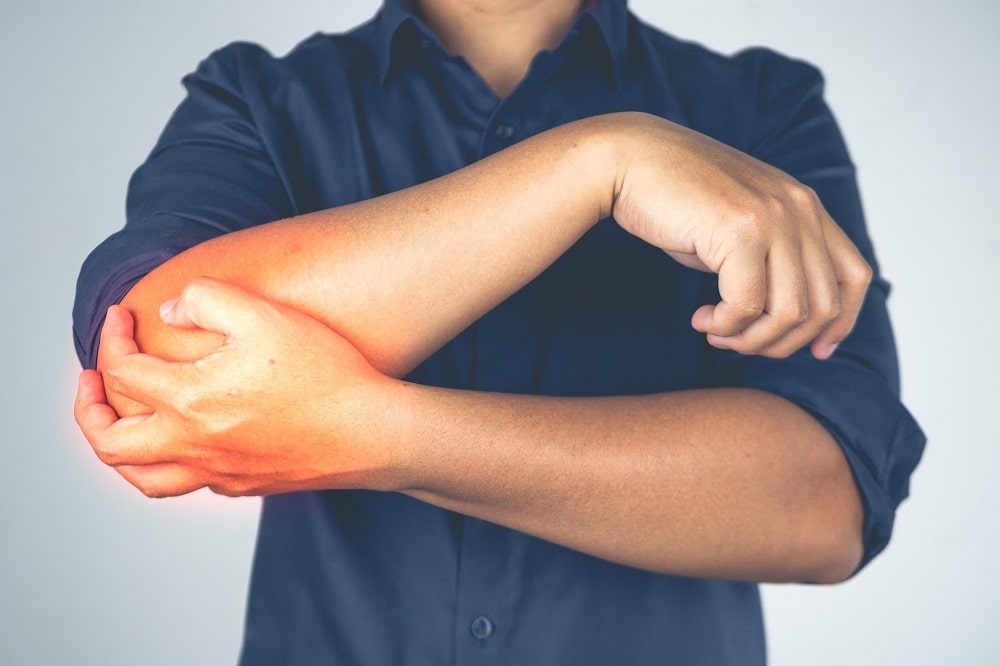Are you experiencing pain in your forearm muscles? This is a common issue that many people deal with, and it can be an inconvenience or even severely limit daily activities. Whether the pain is due to overuse, injury, age-related degeneration, or other causes, we’ve got you covered. This article will provide an overview of forearm muscle pain, including common causes, symptoms, diagnosis and evaluation, treatment options, prevention tips, exercises and stretches for relief, alternative therapies and when to seek medical help. Read on to find out more about relieving your forearm muscle pain.
Understanding Forearm Muscle Pain
Forearm muscle pain is a common complaint in adults of all ages. It can be caused by an injury, strain, or overuse of the muscles in your forearm. This type of pain is typically felt between your elbow and wrist and can range from mild to severe. The most common types of forearm injuries are sprains, strains, and tendinitis. Each injury has unique symptoms and requires specific treatment to ensure a full recovery.


Read More: Stomach Pain After Sex: Causes, Symptoms, and Remedies
What causes forearm muscle pain?
Repetitive Strain Injury (R.S.I.) is a common cause of forearm pain. R.S.I. occurs when you repeatedly use your arms and hands for activities such as typing or using tools, often resulting in inflammation of the tendons and muscles.
Muscle overuse is another common cause of forearm muscle pain. It occurs when you overexert yourself during physical activities, leading to inflammation and soreness in the muscles.
Golfer’s Elbow: Golfer’s elbow is a condition caused by overuse of the flexor muscles in your forearm. It results in pain and tenderness on the inner side of your arm, near the bony lump on the inside of your elbow.
Tennis Elbow: Tennis elbow is similar to a golfer’s elbow but occurs on the outside of your arm, near the bony lump on the outside of your elbow. It is caused by overuse of your forearm muscles and tendons, leading to inflammation and pain.
Strain or Sprain: A strain or sprain can cause pain in your forearms due to an injury that causes swelling, bruising, or tearing of the muscle fibres. This type of injury is often the result of a sudden and forceful movement.
Arthritis: Arthritis can cause pain in your forearms due to inflammation of the joints between your wrists and elbows. The most common types of arthritis that affect the forearm are rheumatoid arthritis and osteoarthritis.
Carpal Tunnel Syndrome: Carpal tunnel syndrome is a common condition affecting the wrist’s median nerve. Symptoms include numbness, tingling, and pain throughout your forearm and hand.
Read More: Sharp Pain in Vagina: Causes, Symptoms, and Treatment
What are the common symptoms of Forearm Muscle Pain?
The most common symptom of forearm muscle pain is a dull or sharp pain in the affected area. You may also experience tenderness and sensitivity to touch, swelling or inflammation, limited range of motion, weakness or difficulty gripping objects, numbness or tingling sensation, and stiffness or tightness. If you have any of these symptoms, it is important to seek medical attention for a proper diagnosis and treatment plan.


Diagnosis and Evaluation
If you experience pain in your forearm, it is important to seek medical attention for a proper diagnosis. Your doctor will take a thorough medical history and perform a physical exam, which may include imaging tests such as an X-ray or M.R.I. to evaluate the extent of your injury. During the evaluation process, they may also request laboratory tests to rule out any underlying medical conditions.
How to relieve forearm muscle pain at home?
There are many treatments available for forearm muscle pain relief that can do at home. These include:
- Resting the affected area and avoiding activities that cause or aggravate your pain.
- Taking over-the-counter medications such as ibuprofen or acetaminophen to reduce pain and inflammation.
- Applying cold therapy, such as an ice pack, to the affected area for 15-20 minutes every 3-4 hours throughout the day.
- Performing gentle stretching exercises to improve flexibility and range of motion in your arms and forearms.
Read More: Can Gallbladder Cause Back Pain: Causes, Symptoms, Cure
Treatment Options for Forearm Muscle Pain
If home treatments are not providing relief, you may require other treatment options to relieve forearm muscle pain. These can include:
– Rest and immobilization: Avoid activities that cause or aggravate your pain and use a brace or splint to keep the affected area still.
– Pain relief medication: Your doctor may prescribe nonsteroidal anti-inflammatory drugs (NSAIDs) or other pain medications to reduce inflammation and relieve discomfort.
– Physical therapy: A physical therapist can help you strengthen and stretch the affected muscles and improve your range of motion. They may suggest exercises that target specific areas, such as shoulder rolls, wrist curls, or elbow stretches.
– Ergonomic modifications: Your doctor may suggest changing your workspace or other activities to reduce muscle strain. This might include using a wrist rest when typing, switching to an ergonomic mouse, or taking frequent breaks during repetitive tasks.
– Heat and cold therapy: Applying heat or cold to the affected area can reduce inflammation and relieve pain. Additionally, massaging the muscle can help improve circulation and relax tight muscles.
– Bracing or Splinting: A brace or splint can help immobilize the affected area and reduce pain. Your doctor may recommend using a neoprene sleeve or other supportive device to provide support while you move your arm.
– Surgery: In some cases, surgery may be necessary to repair the damaged area or remove scar tissue. However, this is usually only recommended when other treatments are not effective.
No matter what type of forearm muscle pain relief you seek, it’s important to talk to a doctor for an accurate diagnosis and treatment plan. With the right medical care, your forearm pain can manage, and you can return to normal activities.
Read More: Diarrhea While Breastfeeding: Causes, Remedies, Precautions
Prevention and Self-Care:
There are several steps you can take to prevent forearm muscle pain and maintain your overall health:
– Take regular breaks from any activities involving repetitive arms and hand motions.
– Avoid activities that require prolonged or heavy lifting.
– Exercise regularly to strengthen your muscles and improve flexibility.
– Stretch your arms and hands regularly.
– Use proper form when engaging in activities that require gripping or using tools.
– Ensure a comfortable workspace or environment with ergonomic chairs, desks, and tools.
By following these guidelines and seeking medical treatment if needed, you can prevent forearm muscle pain and maintain an active lifestyle.
Read More: Back Pain When Breathing Deeply: Causes, Symptoms, Cure
Exercises and Stretches for Forearm Muscle Pain
Stretching and strengthening your forearms can help reduce pain and improve your range of motion. Here are some exercises and stretches that you can do at home:
- Wrist flexion: Place your arm out in front, bent at a 90-degree angle, with the palm facing up. Gently use your other hand to move the fingers downward, then back to the starting position.
- Wrist extension: Place your arm out in front, bent at a 90-degree angle, with the palm facing down. Gently use your other hand to move the fingers upward, then back to the starting position.
- Elbow flexion: Stand with your arms straight by your side and palms facing forward. Bend your elbow and bring your hands towards your shoulders, then back to the starting position.
- Wrist circles: Place your arm out in front with a bent elbow at 90 degrees. Rotate your wrist in clockwise circles, then switch directions to counter-clockwise circles.
- Tricep stretches: Place both arms behind your head and grasp the left elbow with your right hand. Gently pull the left arm closer to your body, then switch sides.
By performing these exercises and stretches regularly, you can reduce stiffness in your forearms and improve your range of motion. As with any exercise routine, it is important to consult a doctor before beginning any exercise program.
Read More: Sharp Breast Pain: Causes, Symptoms, and Treatment Options
Alternative Therapies for Forearm Muscle Pain Relief
In addition to traditional treatments, some alternative therapies can help relieve forearm muscle pain. These include:
– Acupuncture: This holistic approach has been used for centuries to treat musculoskeletal injuries and reduce pain.
– Massage therapy: Massage helps relax the muscles and can improve circulation to the affected area.
– Physical therapy: A therapist can work with you to strengthen and stretch the muscles in your arms, helping to reduce pain and improve your range of motion.
– Biofeedback: This technique uses machines to measure stress levels and help relax tense muscles.
– Yoga: Certain poses may be beneficial in stretching and strengthening the muscles in your arms.
If you’re considering trying an alternative therapy, talk to your doctor first to make sure it’s safe for you.
Conclusion
In conclusion, forearm muscle pain can be managed and relieved with a combination of home treatments, prescription medications, physical therapy, and alternative therapies. It is important to discuss your individual needs with a doctor before beginning any treatment plan. By following the preventive measures outlined in this article and performing exercises and stretches regularly, you can reduce your risk of developing forearm muscle pain and maintain an active lifestyle. ˙
Read More: What Causes Pain Above Belly Button When Pressed?
FAQs
If your forearm pain is accompanied by swelling, redness, and difficulty moving the arm or wrist, it is important to seek medical attention immediately. Additionally, if you experience any tingling or numbness in your arm or hand, this could be a sign of nerve impingement and should be evaluated by a doctor.
Activities that involve gripping objects, repetitive motions, or heavy lifting can cause forearm pain. This includes activities such as using a computer mouse for long periods, playing sports like tennis and golf, and manual labour jobs like carpentry or plumbing.
Forearm pain may last anywhere from several days to weeks or even months, depending on the severity of the injury. In some cases, forearm pain can be chronic and require long-term treatment.
Forearm pain is usually not a sign of heart disease, but it can cause by poor circulation or inflammation of the blood vessels that supply the arm. If you are experiencing other symptoms, such as chest pain, shortness of breath, and forearm pain, it is important to seek medical attention immediately.
There are several natural remedies that can help with forearm muscle pain, such as taking a warm bath or applying a cold compress. Additionally, stretching and strengthening exercises can help reduce stiffness in the muscles and improve the range of motion. Finally, massage therapy and acupuncture may be beneficial in reducing inflammation and promoting healing.

